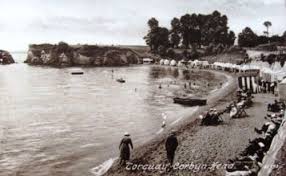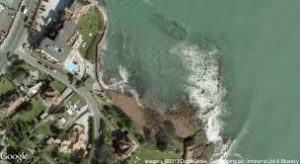“Although the Barn that stands today is a perfectly pleasant place to visit, it is said to house some strange paranormal activity including a stench of decay and disease that can wash over a person in an instant but has no known source.”
Over on Spotted Torquay a terrific photo of Corbyn Head was posted. In response, a few comments came in about the unusual aroma that can often be encountered by the beach huts: “Nice beach!! Shame about the seaweed smell”; “Looks nice but always stinks to high heaven just there?!?!”
This, as many locals will be aware, is the Corbyn Head Stench and isn’t a new phenomenon. We’ll come to the history of the Stench in a moment.
First, the origin of the name of the headland opposite the Grand Hotel. This is Corbyn’s – or Corbyn – Head. The name comes from the Saxon ‘corvenasse’ (cut off headland) and the Norman ‘courbe’ (crooked headland). A grant to Torre Abbey in 1196 mentions ‘twyveldecliv’, the double cliff. The old story that the name came from a pirate called Captain Samuel Corbyn who was hanged on the Head sadly isn’t true.

The Head is formed of Permian breccia around 280 million years old which was deposited in a desert environment similar to the Middle East today. As can be seen in old photos (below left), the Head has greatly eroded over the years. The caves formed by wave erosion have undermined the whole headland, and so a sea wall was built to prevent further wearing away and inevitable collapse.

The granite pyramid monument (below right) on the green was unveiled in 2005, on the 61st anniversary of a tragedy where an artillery gun exploded during a training exercise in August 1944. The gun, an old WW1 Japanese model, was being used in an exercise when one of its 50lb shells exploded in the breech killing six men.

Now we come to the Stench. In a 2014 book, ‘Hauntings. True Life Sightings and Experiences of Ghosts’, the following describes the so-called hauntings of Torre Abbey: “Although the Barn that stands today is a perfectly pleasant place to visit, it is said to house some strange paranormal activity, including a stench of decay and disease that can was over a person in an instant but has no known source.” And, for many years, Torquay was plagued by what was called, “a shop window problem” which was “one of the most important difficulties which Torbay Corporation has had to face”. This irritant became known as the Corbyn Head Stench, an aroma which emanated from the beach in front of the Grand Hotel. Particularly embarrassing was that, due to Torquay Station’s location, tourists were often able to smell the beach before they could see it. To the horror of our tourism industry it was suggested that we had a sewage problem.
Back in August 1938 Mr A Hill, a well known local architect, presented a petition of 150 names and told the Torquay Directory: “The odour given off by fresh seaweed in a breeze is not at all unpleasant, but this is the accumulation of years. Every time the tide goes out there is left behind a residue of mud some inches thick, consisting of decomposed seaweed and other matter which gives off sulphated hydrogen. When the sun plays on it, it is nauseating. Nobody will eat their food at Corbyn nowadays and hardly anybody will fight their way through the black, obnoxious thick mud to bathe. They all go over to Torre Abbey Sands.” It was agreed that one cause of the smell was the seaweed which decomposed in the natural channel between the rocks. The Council then removed the seaweed by having workmen work all night at low tide. However, this was laborious and slow as lorries couldn’t be brought on to the beach. One proposed solution was to bring a barge into the channel, ground it, fill it with seaweed and then refloat it on the next tide. Mr Hill wanted this plan to be put into action immediately: “All we want is to have the beach cleared of the foul, black mud and seaweed. Give me a dozen unemployed men with scoops and brushes and a barge and in three low tides I will clear the lot at a total cost of £50.”
It was agreed that one cause of the smell was the seaweed which decomposed in the natural channel between the rocks. The Council then removed the seaweed by having workmen work all night at low tide. However, this was laborious and slow as lorries couldn’t be brought on to the beach. One proposed solution was to bring a barge into the channel, ground it, fill it with seaweed and then refloat it on the next tide. Mr Hill wanted this plan to be put into action immediately: “All we want is to have the beach cleared of the foul, black mud and seaweed. Give me a dozen unemployed men with scoops and brushes and a barge and in three low tides I will clear the lot at a total cost of £50.”

However, the problem had been studied by Council officials for some years and finally the Ministry of Agriculture had been approached for advice. It was then suggested that seaweed wasn’t the only, or even the main, cause of the Stench. It was found that there were, “Vast beds of decomposed peat which lie under the Sea Front, the Grand Hotel, Abbey Gardens and the Recreation Ground. When the tide rises, the water percolates into these beds and when the tide recedes the water that has been in contact with the peat drains back into the sea. It is, of course, contaminated and gives off the offensive odour. These peat beds are the remnant of the days when trees came right down to the waters’ edge. The vegetation rotted and formed the peat which became covered over as time went by.”
Whatever the primary cause of the Corbyn Head Stench, all were agreed on one thing. “It can definitely be stated that the smell does not emanate from any sewerage. Corporation officials proved that a long time ago”, the Council announced.

The Second World War then broke out so we probably had better things to worry about. Now we’ve largely overcome the worst of the Stench, though on some days the invisible miasma rises again.
Leaving the Head, to the north is Torre Abbey Sands. This beach was once known as Cause Way End Sands. The title referred to the ancient causeway that ran between Torre Abbey Gates and the sea. It was built to cross marshy land to a “rude quay” and was used to bring goods and people from the beach to the Abbey. When the sea wall was built, the need for a causeway ended. This route, which was vital for centuries, is now buried beneath King’s Drive.
Between Kings Drive and the Bowling Green is where the Scirewell Brook finally finds its way to the sea. This stream was the manorial boundary between Torre and Cockington. A smaller tributary was Efride’s Brook which shares its name with St Efride’s Road – from the Saxon word ‘efre’ meaning constant ever flowing stream. There was no St. Efride, however. In 1867 a drinking fountain was placed on the old well opposite Torre Church.

Over the years, Scirewell Brook became Sherwell Brook, and has lent its name to the valley and hills where it began its journey. If you follow the Scirewell Brook inland from the sea – just before the gates of the Pretty Park (pictured above) – you come to where the Fulforde Mill used to stand until it was pulled down sometime between 1875 and 1880. The mill is remembered in Old Mill Road. As with so many places in Torquay, new technology destroyed a lifestyle, but traces remain in local names.

Let’s close with a bit of a mystery. From Corbyn Head in the direction of Paignton is Livermead, from ‘laefer mead’, ‘the meadow of the wild iris’. At low tide you can see what remains of Torquay’s original medieval harbour off Institute Beach (pictured above). Yet, no one seems to know why Institute Beach is so called. There are a few suggestions but nothing concrete. So if anyone does know, do get in touch.
For more local news and info, go to our home page or you can join us over on Facebook or Twitter.










